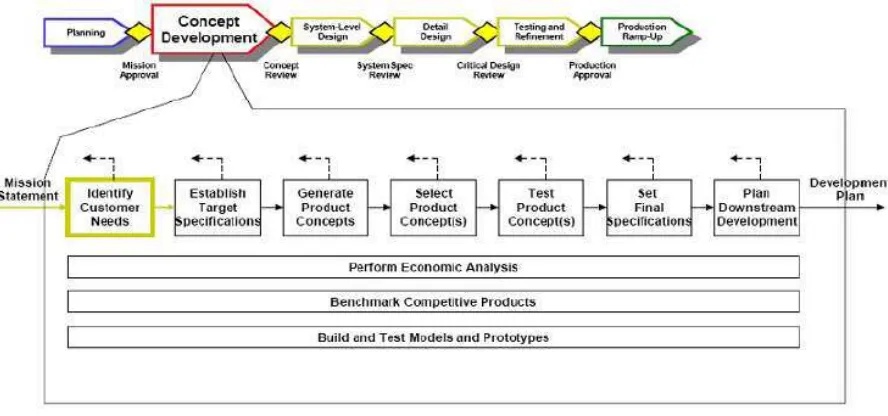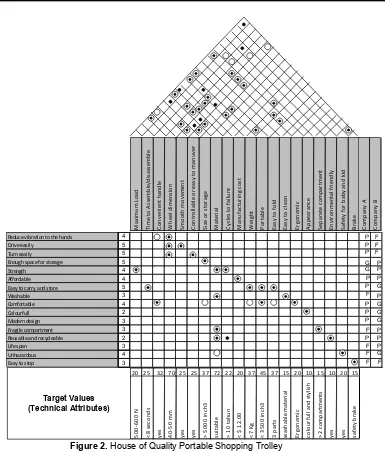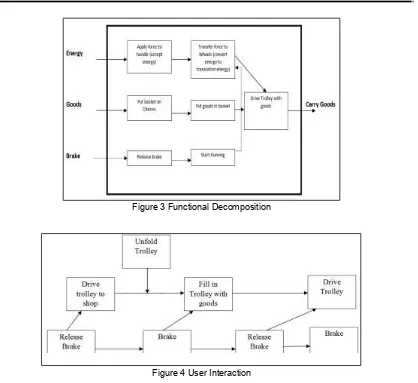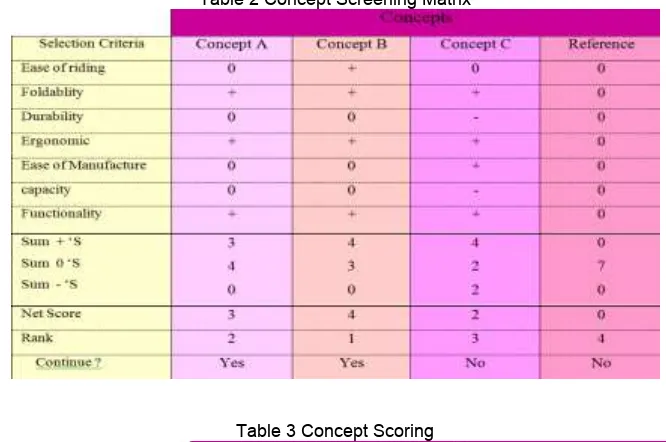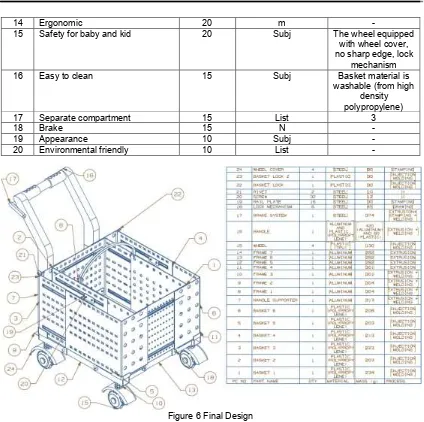495
Integrating of Quality Function Deployment for Product
Design and Development of Portable Shopping Trolley
Melfa Yola
Faculty of Science and Technology Universitas Islam Negeri Sultan Syarif Kasim
Pekanbaru, Riau
Abstrak
Untuk bersaing secara internasional, tidak cukup hanya membangun suatu produk. Saat ini, pelanggan memiliki banyak pilihan untuk memilih satu produk. Karena kondisi ini, produsen harus membuat yang memenuhi atau melebihi kebutuhan dan harapan pelanggan. Quality Function Deployment (QFD) adalah salah satu alat unik yang membantu perusahaan untuk merencanakan dan merancang produk untuk memenuhi kebutuhan pelanggan. QFD merupakan metode terstruktur untuk perencanaan produk yang membantu tim proyek produk untuk mewakili kebutuhan pelanggan dan kemudian mengevaluasi bagaimana dan apakah perusahaan dapat memenuhi kebutuhan ini. Penelitian dalam makalah ini menyajikan penerapan Quality Function Deployment dalam desain produk dan fase pengembangan untuk mengembangkan Trolley Belanja Portable. Tiga konsep desain dibangun untuk mendapatkan konsep terbaik yang memenuhi harapan dan kebutuhan pelanggan. Hasilnya akan disajikan dalam gambar dan spesifikasi akhir.
Kata Kunci : Perancangan dan Pengembangan Produk, Quality Function Deployment (QFD), Portable
Shopping Trolley
Abstrak
To compete internationally, it is not enough just building a product. Today, customers have a lot of choice to choose one product. Due to this condition, manufacturers need to create a product that satisfy
or exceed customers’ needs and expectation. Quality Function Deployment (QFD) is a unique tool that
helps a company to plan and design products to meet customers’ needs. QFD is a structured method for product planning that helps a product project team to represent the customers’ needs and then evaluate
how and whether the company can meet these needs. The study in this paper presents an implementation of Quality Function Deployment in product design and development phases for developing Portable Shopping Trolley. Three design concepts are built to get the best concept that fulfill customers’ needs and expectation. The result will be presented in drawing and final specification.
Keywords : Product Design and Development, Quality Function Deployment, Portable ShoppingTrolley
1. Introduction
One of human’s characteristic is that they are always trying to create something, whether tools or other objects to help their lives. The object to be designed always expected to be better than the previous object, making it more helping humans in their jobs. In the past, drawing and design activities is almost never done before the manufacturing process. And by the time with the increasing of studies, people are increasingly aware that design is needed before producing the product to make a better product and suitable with customer expectation.
A shopping trolley is a cart supplied by a shop, especially supermarkets, for used by customers inside the shop for transport of merchandise to the check-out counter during shopping. Customers can then also use the trolley to transport their purchased goods to their cars. Practically all modern shopping trolley are made of metal or a combination of metal and plastic and have been designed to nest within each other in a line to facilitate collecting and moving many at one time and also to save on storage space. The first shopping trolley was invented by Sylvan Goldman in 1937. Sylvan Goldman owned a supermarket chain in Oklahoma, and he noticed his customers struggling to carry their groceries in over filled, heavy hand baskets. With the help of a mechanic, Fred Young, he made the first shopping trolley prototype from a folding chair, wheels, and a pair of wire baskets.
496
attach to a wheel chair, shallow shopping trolleys - for people who don't need a full size trolley, or for people with back problems that have difficulty bending down to unload them.
Most users of these products are women, and a great number of them feel that these products are helping them in the shop, especially in places where do not provide shopping trolli such as traditional markets, stores or just for carrying goods from car to the house. But the avalaible products in the market are still very limited in terms of diversity of design and price, where there are still a lot of consumers complained about the lack of existing products as well to the design and materials used.
2. Literature Review
The product can be interpreted as the obtained output from a production process (transformation) or an increment value of raw materials (input materials) or a company sold commodities to sell to the consumer [10]. The transformation process will result in changes of shape and physical dimensions of the raw material and other material properties in accordance with the design. This transformation process will be positive if followed by the value added of the output produced, either functional or economic value added.
The stages/phases of Product Design and Development are as follows [9]:
2.1. Identifying Customer Needs
Identifying customer needs is an integral part of the product development process. Figure 1 show the customer needs activity in relation to other concept development activities.
Figure 1 The Customer Needs Activity in Relation to Other Concept Development Activities
In identifying customer need, this process involve five (5) steps which are: 1) Gather Raw Data
2) Interpret Raw Data
3) Organize the Needs into a Hierarchy
4) Establish the Relative Importance of the Needs 5) Reflect on the Results and the Process
2.1.1. Quality Function Deployment (QFD)
The Quality Function Deployment is a structured method that is used in the planning process and product development to define the specifications needs and desires of consumers, as well as systematically evaluate the capabilities of a product or service to meet the needs and desires of consumers. The purpose of the Quality Function Deployment is not only meet customer expectations, but also try to exceed customer expectations as a way to compete with competitor, so that consumers are not expected to reject and not complain, but instead want it.[6]
2.2. The Establishing of Target Specifications
497
2.3. Competitor Product Analysis (competitive benchmarking)
This is a critical step to realize the success of a product, and can provide a rich resource for ideas that can be donated to the product itself or the process of designing products. It aims to support the determination of the specification, generation, and concept selection.
2.4. The Establishing of Product Concept
The aim is to explore a wide range of product concepts that can be determined in accordance with the wishes of consumers. The Establishing of the concept is done by combining the results of research conducted from external and internal, as well as the systematic development of the resulting solution.
2.5. Concept Selection
This is an activity in which some of the various product concepts are analyzed and removed on a regular basis to get the best concept. This process usually requires several iterations and may put some additional preparation and repair for the concept.
2.6. Concept Testing
The concept testing is done to find out what customers and the market think about the product. In a concept testing, the development team solicits a response to a description of the product concept from potential customers in the target market. This type of testing may be used to select one concept from several concepts, and gather information from potential customers on how to improve a concept, and estimate the potential sales of the product
2.7. Set Final Specification.
This is the last step before the product is manufactured. The final specification is the best decided concept for customer.
3. Metodologi
Portable Shopping Trolley is designed based on the identification of customer needs by using the method of Quality Function Deployment and then the products are designed based on the stages / phases of product development.
Data is collected by questionnaires and interviews to the consumers to see the hidden needs (unvisible needs). Validation and realibility test are used after questionnaires are spreaded.
4. Finding
At this process, the interaction with the customer about the important types of needs in the target market are shown in Table 1. These importance needs are obtained from the result of questionnaires.
Table 1 The Relative Importance Data of Customers’ Expectation
No Needs
1 Reduce vibration to the hands 2 Drive easily
3 Turn easily
4 Enough space for storage 5 Strength 13 Reusable and recycleable 14 Life span
498
Figure 2. House of Quality Portable Shopping Trolley
Based on these importance needs then Quality Function Deployment can be built. Figure 2 show house of quality for portable shopping trolley. Here, customers’ requirements are translated into technical requirements. Then target specifications are built for new concept of product.
499
Figure 3 Functional Decomposition
Figure 4 User Interaction
After user interaction is found out, the next step is searching externally and internally. Searching externally to find out the excess of other product and also to search some part that cannot be produce by manufacturer. Here, to achieve target smooth movement and controllable the company can use the wheel from other manufacturer. This is due to the complexities and difficulties in manufacturing a good wheel for trolley. Searching internally is important to create some idea for future portable shopping trolley. Figure 5 shows three concept for the next portable shopping trolley.
Figure 5 Concepts Design
500
Table 2 Concept Screening Matrix
Table 3 Concept Scoring
Table 4 Final Specification
os Metric Imp
Rating
Units Value
1 Size or storage 72 Inch3 7406
2 Weight 70 Kg 5
3 Portable 45 In3 3360
4 Controllable or easy to manuever 37 Subj The wheel equipped with cylinder
bearing
5 Manufacturing cost 37 $ 12
6 Easy to fold (procedure) 37 No 3
7 Convenient handle 32 Subj Equipped with
finger shape
8 Time to assemble/disassemble 25 S <8
9 Wheel dimension (radius) 25 Mm 45
10 Smooth movement 25 Subj The wheel equipped
with cylinder bearing
11 Material 22 List -
12 Max. Load 20 N 675
501
The integration of Quality Function Deployment (QFD) in Product Design and Development is done to get the ranking of needs (Importance Needs). The discussion above suggest that Quality Function Deployment is one of the best way to get the importance needs for developing the product, but this is not the only tools to get the rank of importance needs. To get the rank of importance needs for a new product, it can be compared with other familiar products which has similarities.
References
[1] Cristiano, John J, dkk “ Customer-Driven Product Development Through Quality Function Deployment in the U.S and Japan”., Journal Production Innovation Management., 2000
[2] Griffin, Abbie dan Hauser, John R., “The Voice of Customer”., International Journal of Marketing Science., 1993
[3] Rawabdeh Ibrahim, dkk., “Design and Development of a New Quality Function DeploymentSoftware Tool”., International Conference - Grand Hotel - Rimini – Italy - Sept. 5th-7th, 2001
[4] Delgado, D.J dan Aspinwall, E.M., “QFD Methodology and Practical Applications-A Review”., Proceedings of the Ninth Annual Postgraduate Research Symposium, School of Engineering, The University of Birmingham., 2003
[5] Akao, Yoji. “Quality Function Deployment: Integrating Customer Requirement into Product Design”. Oregon: Productivity Press. 1998
[6] Cohen, Lou. 1995. “Quality Function Deployment, How to Make QFD Work for You”. Massachussetts: Addison Wesley Publishing Company.
[7] Day, Ronald G. 1993. Quality Function Deployment : Linking a Company with Its Customers. Milwaukee, Wilconsin: ASQC Quality Press
502
[9] Ulrich, Karl T dan Eppinger, StevenD., “Product Design and Development” fifth edition., Mc-Graw Hill., 2008
[10] Widodo, Imam Djati., “Perencanaan dan Pengembangan Produk” UII Press 2009 [11] Sullivan, L., “Quality Function Deployment”, Quality Progress, June 1986
[12] Chan, L. K. and Wu, M. L., 2002b, Quality function deployment: A literature review, European Journal of Operational Research, 143(2002), 463-497
[13] Govers, C.P.M., 1996, What and how about quality function deployment (QFD), International Journal of Production Economics, 46-47(1996), 575-585
[14] Owlia, M.S. and Aspinwall, E.M., 1998, Application of quality function deployment for the improvement of quality in an engineering department, European Journal of Engineering Education, 23(1), 105-115 [15] Zairi, M. and Youssef, M. A., 1995, Quality function deployment – A main pillar for successful total
